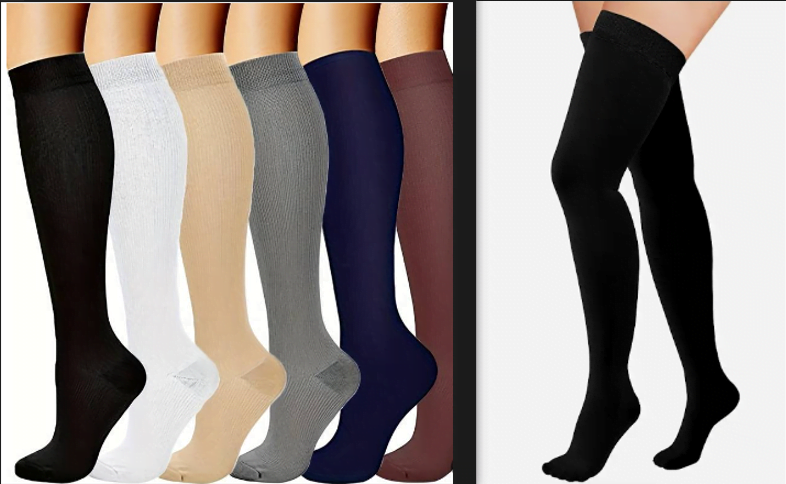NU-KNIT Surgicel is an Oxidized regenerated cellulose (ORC) type of material produced through a process where cellulose is chemically modified and oxidized to create a material with unique absorbable Hemostat properties. It consist of a matrix that encourages platelet adhesion and aggregation to stop bleeding.
Commonly used in medical applications, particularly in surgery, as a hemostatic agent to control bleeding in small blood vessels such as capillaries, small arteries and veins when methods of bleeding control are impractical or ineffective.
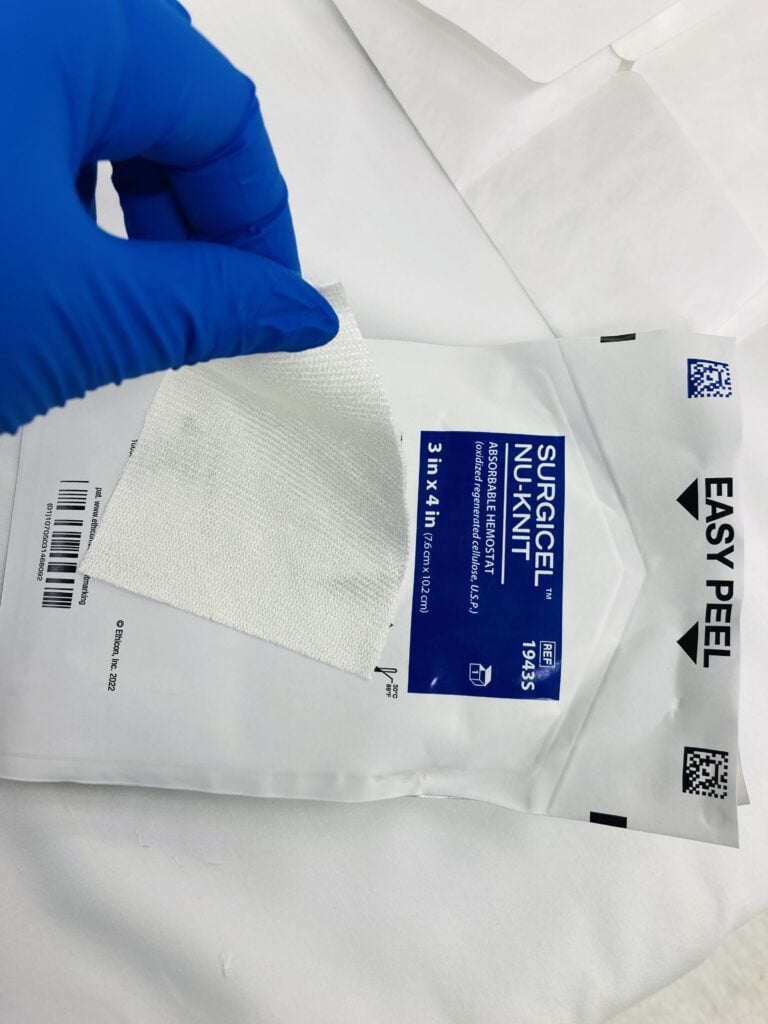
Its high absorbency and ability to promote clotting make it useful for controlling bleeding in surgical wounds. It is biocompatible, meaning it is well-tolerated by the body and does not typically cause adverse reactions.
What dose NU-KNIT looks like?
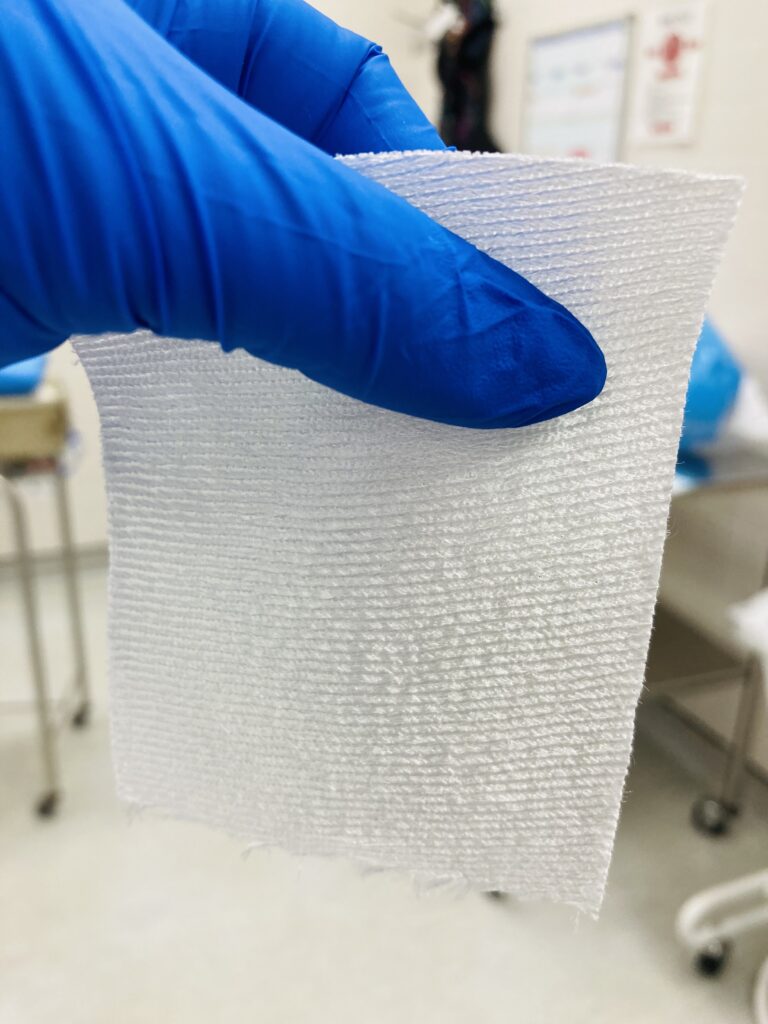
NU-KNIT is typically made from a biocompatible material like oxidized cellulose. It comes in the form of a mesh or fabric, which can be easily applied to the bleeding site.
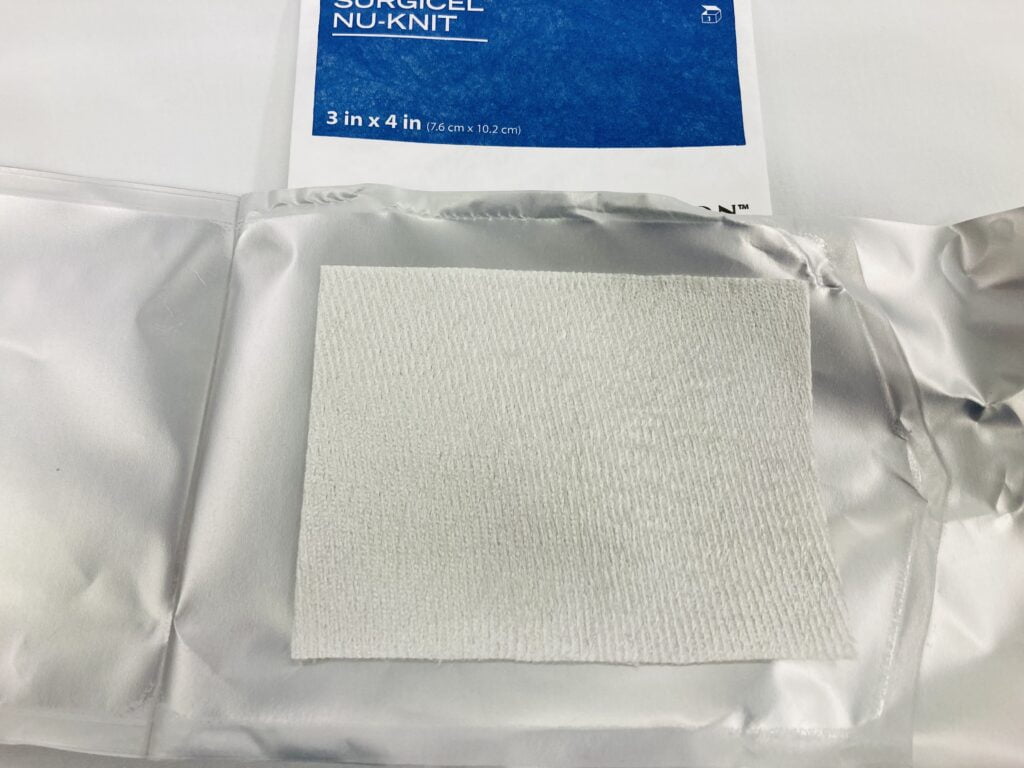
How NU-KNIT works to control bleeding and promote clot formation
1. Application: When NU-KNIT Surgicel mesh or fabric, is applied to the bleeding site it absorb blood rapidly and creates a matrix for platelet adhesion. NU-KNIT take blood away from the wound surface, helping to stop the flow of blood.
2. Promotion of Clot Formation: NU-KNIT facilitates clot formation through several mechanisms:
- Activation of Platelets: NU-KNIT can activate platelets, which are essential for the formation of blood clots. When NU-KNIT comes into contact with blood, it triggers a cascade of biochemical reactions that lead to platelet activation.
- Enhancement of Fibrin Formation: Fibrin is a protein that forms the structural framework of blood clots. NU-KNIT can enhance the formation of fibrin by providing a scaffold for fibrin strands to adhere to, thereby strengthening the clot.
- Local Concentration of Coagulation Factors: NU-KNIT can concentrate coagulation factors at the site of the wound, accelerating the clotting process.
3. Hemostatic Action: NU-KNIT exerts direct pressure on the bleeding vessel, helping to seal it off and prevent further blood loss. Additionally, its physical presence at the wound site helps to promote the formation of a stable clot.
Overall, NU-KNIT functions as an effective hemostatic agent by rapidly absorbing blood, promoting platelet activation and fibrin formation, and providing a scaffold for clot formation. Its ability to control bleeding makes it an invaluable tool in surgical settings where precise hemostasis is essential.
Preparation Time & Absorption Time of Surgicel Nu-Knit
Surgicel Nu-Knit comes in a sterile packet.
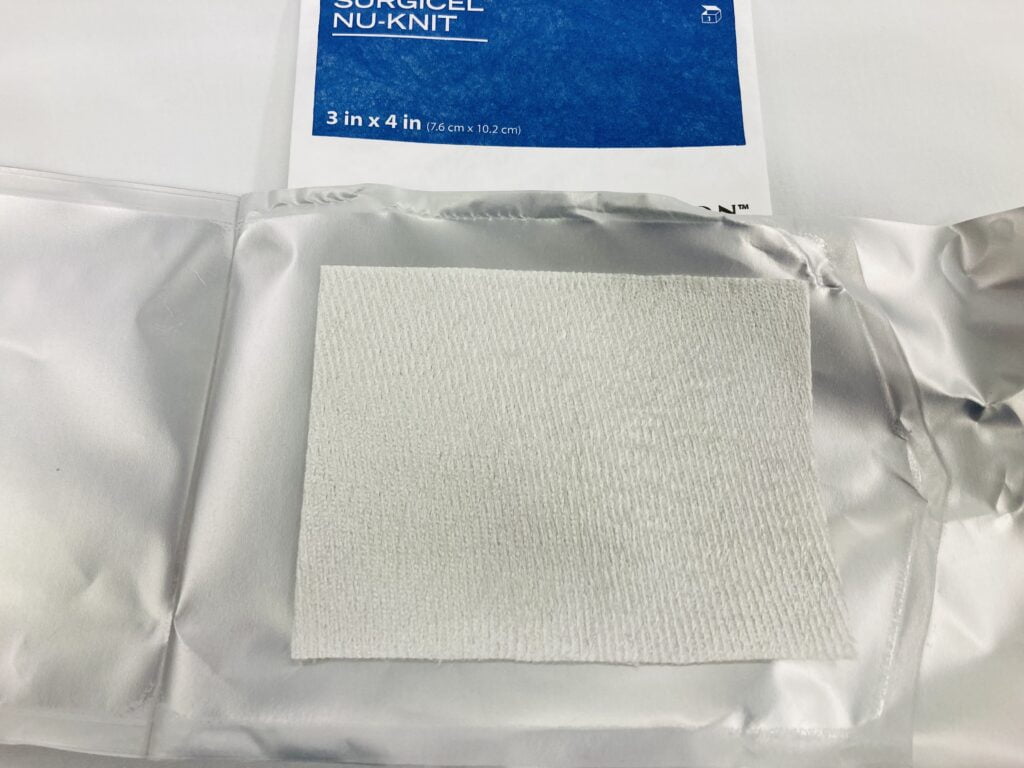
The preparation time for Surgicel Nu-Knit involves unpacking the product and ensuring a sterile environment for its use. This typically includes opening the packaging in a clean area, using sterile gloves and instruments, and preparing the surgical site as per standard protocols.
Once prepared, Surgicel Nu-Knit can be applied to the bleeding site. It should be used only as much as necessary to achieve hemostasis, and excess material should be removed before surgical closure to aid in absorption and minimize the risk of foreign body reaction.
Absorption time:
The absorption time of Surgicel Nu-Knit may vary depending on factors such as the amount used, the nature of the tissue, and the individual patient’s healing process.
Generally, Surgicel Nu-Knit is absorbed over time by the body’s natural processes. It is designed to be absorbable and gradually breaks down within the body, typically over a period of 7 – 14 days.
It’s essential for healthcare providers to monitor the absorption process and ensure that Surgicel Nu-Knit does not cause any adverse reactions or complications during the healing period. If necessary, any remaining material should be removed from the surgical site once hemostasis is achieved and the bleeding has stopped.
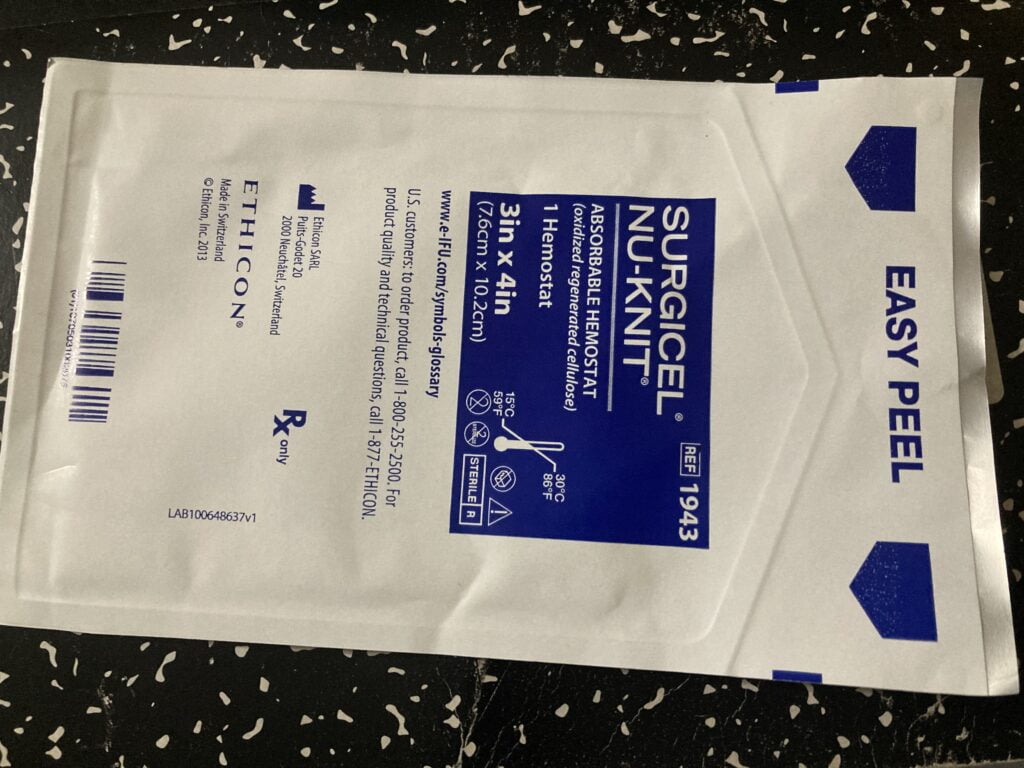
Step-by-step guide on how to apply NU-KNIT Surgicel
1. Prepare the Wound: Before applying NU-KNIT Surgicel, ensure that the surgical site is adequately prepared. This includes controlling bleeding as much as possible using standard surgical techniques such as pressure, ligature, or electrocautery.
2. Select the Appropriate Size: NU-KNIT Surgicel comes in various sizes and shapes to accommodate different wound sizes and shapes. Choose the appropriate size of NU-KNIT Surgicel based on the size and location of the wound.
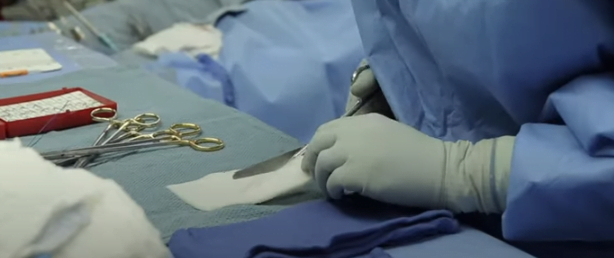
3. Sterilization: Ensure that NU-KNIT Surgicel remains sterile until application. Open the sterile package containing the NU-KNIT Surgicel just before use, and handle it with sterile gloves.
4. Place the NU-KNIT Surgicel: Gently place the NU-KNIT Surgicel directly onto the bleeding site or the raw surface of the wound. Ensure that the entire bleeding area is covered by the NU-KNIT Surgicel.
5. Apply Pressure: Apply firm, direct pressure to the NU-KNIT Surgicel using sterile gauze or a surgical sponge. This pressure helps to enhance hemostasis by promoting the adherence of the NU-KNIT Surgicel to the wound and by compressing the bleeding vessels.
6. Secure in Place: Once the NU-KNIT Surgicel is in position and pressure is applied, secure it in place using sutures, surgical clips, or other appropriate wound closure methods. This prevents dislodgment of the NU-KNIT Surgicel and ensures that it remains in contact with the bleeding site.
7. Monitor and Assess: After application, closely monitor the patient for any signs of continued bleeding or adverse reactions. Continuously assess the wound for adequacy of hemostasis and overall healing progress.
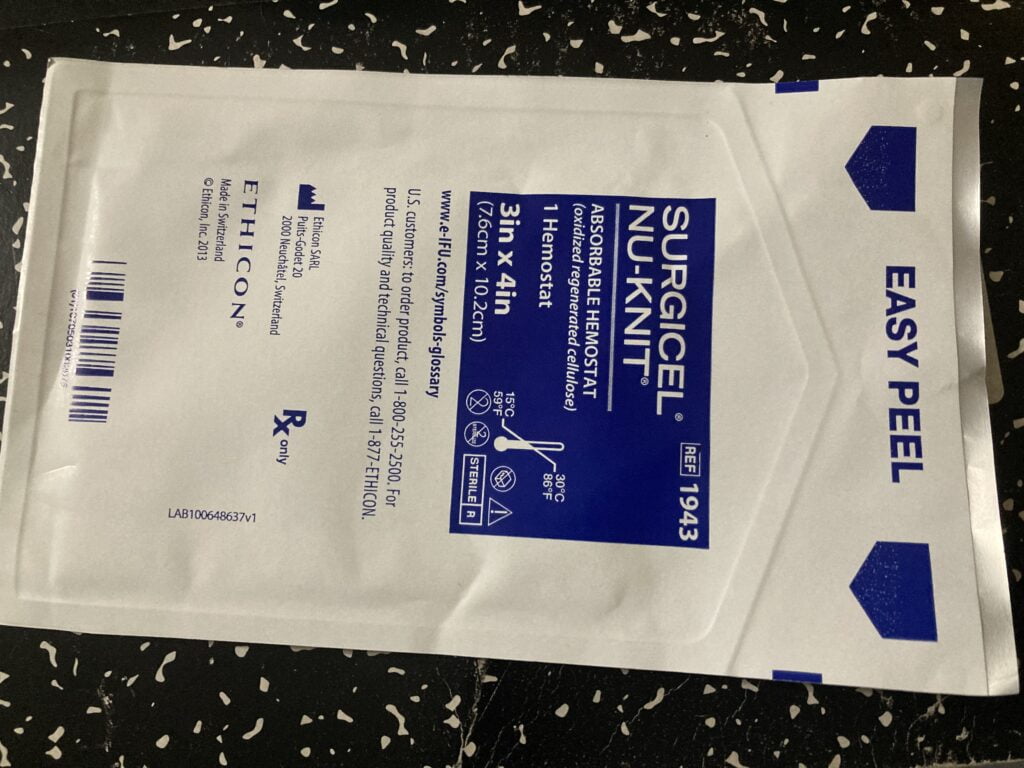
8. Documentation: Record the application of NU-KNIT Surgicel in the patient’s medical records, including the size used, location of application, and any relevant clinical observations.
Following these steps ensures proper application of NU-KNIT Surgicel and promotes effective hemostasis in surgical wounds. It’s essential to adhere to sterile techniques and to closely monitor the patient post-application for optimal outcomes.
Surgical procedures and scenarios where NU-KNIT is commonly used
| Surgical Procedure/Scenario | NU-KNIT Application |
|---|---|
| Cardiovascular Surgery | NU-KNIT can be used for suturing and reinforcing vascular grafts. |
| Orthopedic Surgery | In orthopedic procedures, NU-KNIT can aid in ligament and tendon repairs. |
| Neurosurgery | NU-KNIT may assist in delicate nerve repairs and dural closures. |
| Plastic Surgery | It can be utilized in cosmetic procedures such as wound closure and tissue reconstruction. |
| General Surgery | NU-KNIT is often used for abdominal closures and wound management. |
| Urological Surgery | In urological procedures, NU-KNIT can be used for bladder reconstruction and urethral repairs. |
| Gynecological Surgery | It can assist in hysterectomy procedures and vaginal wall repairs. |
NU-KNIT is a versatile surgical tool that can be employed in various surgical specialties for wound closure, tissue repair, and reinforcement. Its biocompatibility and ease of use make it a valuable asset in modern surgical practice.
Advantages & Disadvantages of Using Surgicel Nu-Knit
Advantages of Surgicel Nu-Knit
1. Efficiency: NU-KNIT is designed to quickly and effectively stop bleeding, providing rapid hemostasis. This can be particularly beneficial in emergency situations where time is critical.
2. Versatility: NU-KNIT can be used in both minor procedures, such as wound closure in the emergency room, and major surgeries, including cardiovascular and neurosurgical procedures. Its versatility makes it a valuable tool across various medical specialties.
3. Reduced Tissue Trauma: Unlike sutures, which require puncturing and tying off tissue, or cautery, which can cause thermal damage, NU-KNIT minimizes tissue trauma. This can lead to faster healing times and reduced scarring.
4. Lower Infection Risk: Sutures and cautery can introduce bacteria into the wound, increasing the risk of infection. NU-KNIT provides a barrier against pathogens, helping to reduce the risk of postoperative infections due to its bactericidal properties. It lowers the pH in Blood causing vasoconstriction, this creates and environment inhospitable to bacteria.

5. Reduced Blood Loss: By effectively controlling bleeding, NU-KNIT helps to minimize blood loss during surgery. This can lead to better patient outcomes and reduce the need for blood transfusions.
6. Enhanced Visualization: NU-KNIT is typically colorless and transparent, providing surgeons with improved visualization of the surgical site compared to traditional methods. This can help ensure more precise placement and better surgical outcomes.
7. Convenience: NU-KNIT is easy to use and does not require specialized training or equipment. This makes it a convenient option for healthcare providers and can help streamline surgical procedures.
8. Consistent Performance: NU-KNIT’s hemostatic efficacy is reliable across different patient populations and types of bleeding. This consistency allows surgeons to have confidence in its performance, leading to better surgical outcomes.
9. Stabilize : very dense and suitable for wrapping and suturing compare to other hemostatic agents. Nu-Knit is three times denser and finer than Surgicel Original Absorbable Hemostat, resulting in a hemostasis time that is over 36% faster.
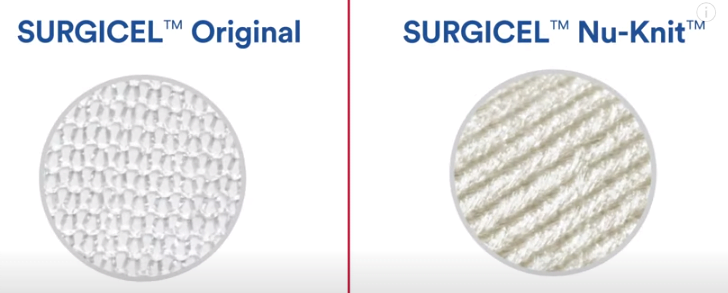
Disadvantages of Surgicel Nu-Knit
1. Foreign Body Reaction: Nu-Knit Surgicel is a synthetic material made from oxidized regenerated cellulose. In some cases, the body may react to this foreign material, leading to inflammation or tissue irritation.
2. Infection Risk: Any foreign material introduced into the body, including Nu-Knit Surgicel, carries a risk of infection. Although rare, infection can occur at the site of application, leading to complications.
3. Limited Efficacy: While Nu-Knit Surgicel is effective in many cases, it may not be suitable for controlling all types of bleeding. In some situations, alternative hemostatic agents or techniques may be more appropriate.
4. Granuloma Formation: Prolonged exposure to Nu-Knit Surgicel may result in the formation of granulomas, which are nodular masses of immune cells. These granulomas can cause discomfort and may require additional medical intervention.
5. Handling Challenges: Nu-Knit Surgicel can be fragile and may tear or break during handling, particularly if not moistened adequately before application. This can make it challenging to use effectively, especially in delicate surgical procedures.
6. Potential for Adhesion: In some cases, Nu-Knit Surgicel may adhere to surrounding tissues, which can make it difficult to remove and may cause tissue damage during extraction.
7. Storage Requirements: Nu-Knit Surgicel typically requires specific storage conditions to maintain its integrity and efficacy. Improper storage may compromise its performance and increase the risk of complications during use.
8. Allergic Reactions: Although rare, some individuals may experience allergic reactions to components of Nu-Knit Surgicel, leading to symptoms such as itching, rash, or swelling.
9. Limited Research on Long-Term Effects: While Nu-Knit Surgicel has been in use for many years, there may be limited long-term data on its effects, including potential risks associated with prolonged exposure or repeated use.
Factors and situations where you should not use Surgicel Nu-Knit
1. Not recommended for packing or wadding surgical site unless it’s going to be removed after stopping the bleeding.
2. Should not be use for placing into bone defects like fractures. Doing so might disrupt the formation of callus and could potentially lead to cyst formation.
3. Should not be used to control hemorrhage from large arteries.
4. Avoid applying SURGICEL Nu-Knit on surfaces that are oozing serous fluids, as it is designed specifically for whole blood. Using it on such surfaces may not yield the desired hemostatic effect.
5. Should not be used as an adhesion prevention product.
Important instructions for the use of Surgicel Nu-Knit
1. Use only as much Surgicel Absorbable Hemostat as necessary for hemostasis. Hold it firmly in place until bleeding stops.
2. Remove any excess Surgicel Nu-knit before surgical closure to facilitate absorption and minimize the risk of foreign body reaction.
3. In urological procedures, use minimal amounts of Surgicel Nu-Knit to avoid plugging the urethra, ureter, or catheter with dislodged portions of the product.
4. Avoid using Surgicel Nu-knit in chemically cauterized areas, as its absorption may be prevented.
5. If Surgicel Nu-knit is temporarily used to line the cavity of large open wounds, ensure it does not overlap the skin edges. Remove it from wounds after bleeding stops, either with forceps or irrigation with sterile water or saline.
6. Take precautions in otorhinolaryngologic surgery to prevent aspiration by the patient, especially when controlling hemorrhage after tonsillectomy or epistaxis.
7. When using Surgicel as a wrap during vascular surgery, avoid applying it too tightly to prevent adverse reactions (refer to the Adverse Reactions section of the product package insert).
Storage Requirements & Shelf Life of Surgicel NU-KNIT
1. Storage Requirements:
- Surgicel NU-KNIT, like other surgical products, should be stored in a cool, dry place away from direct sunlight.
- To ensure its integrity, storage temperature and conditions of NU-KNIT must be in a controlled room temperature 59º-86ºF (15º-30ºC)
2. Shelf Life:
- The shelf life of Surgicel NU-KNIT typically depends on various factors, including the manufacturing process and packaging.
- Generally, it should have an expiration date printed on the packaging. It’s crucial to use the product before this date to ensure its effectiveness and safety.
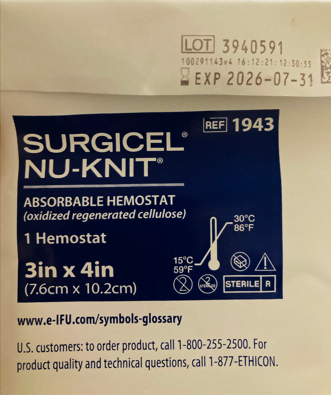
- Once opened, the remaining Surgicel NU-KNIT should be discarded according to the instructions provided by the manufacturer, typically to prevent contamination and maintain its sterile properties.
- Has a Shelf life of 5yrs.
How was Surgicel NU-KNIT made?
Nu-knit start out as Tree pulp and through chemical process it is regenerated to cellulose (Rayon) to create uniform fibers. It the goes through an oxidation process that turns the regenerated cellulose textile into a material (Nu-Knit).
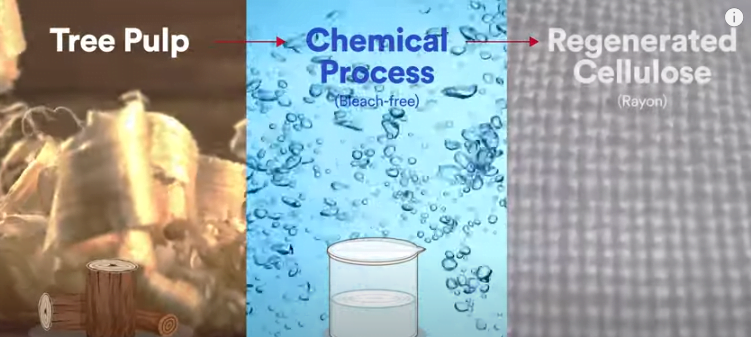
RESOURCES:
Work Experiences: As an OR registered nurse I have my years of experiences working with this product and watching and learning from well Experience surgeons the unique qualities of NU-KNIT.
Rino Y et al. (2014) investigated NU-KNIT® for hemostasis during esophagectomy with lymphadenectomy. 2014 Mar 6;7:127. doi: 10.1186/1756-0500-7-127. PMID: 24602313; PMCID: PMC3973846.
https://www.jnjmedtech.com/en-US/product/surgicel-nu-knit-absorbable-hemostat



